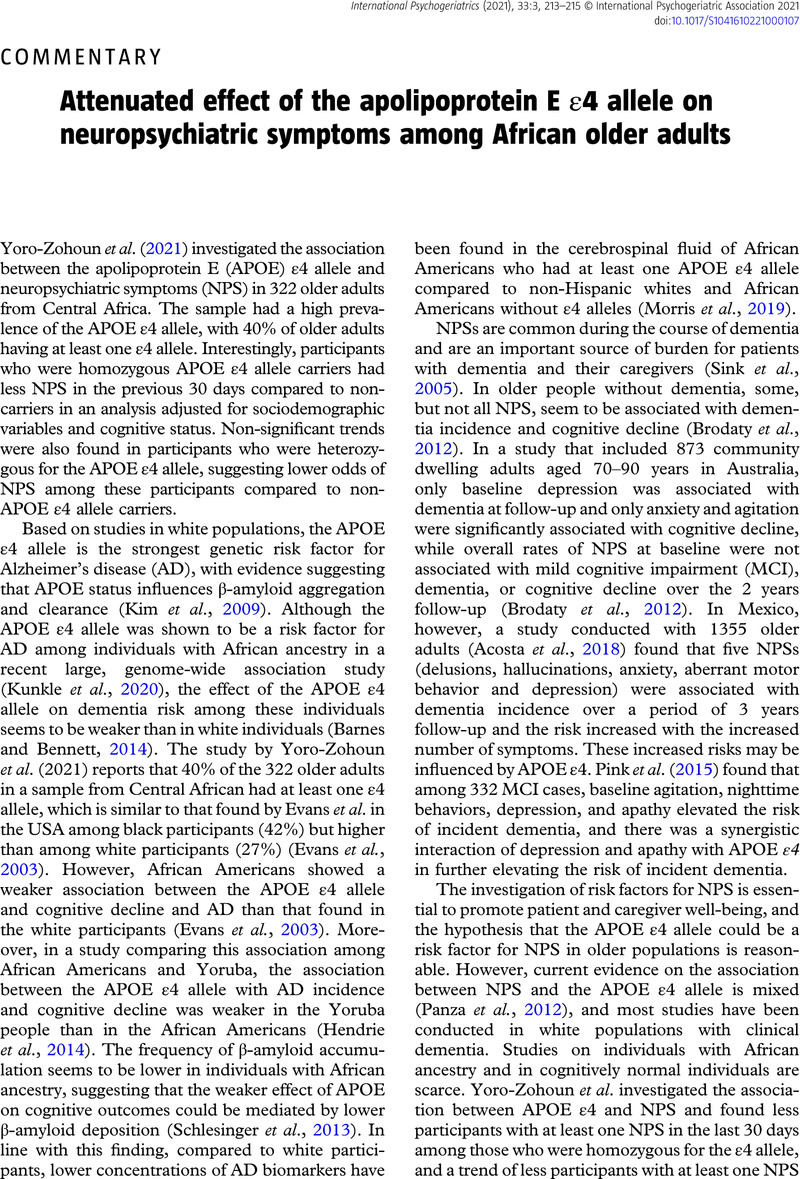Crossref Citations
This article has been cited by the following publications. This list is generated based on data provided by Crossref.
Katsumata, Yuriko
Fardo, David W
Shade, Lincoln M P
Bowen, James D
Crane, Paul K
Jarvik, Gail P
Keene, C Dirk
Larson, Eric B
McCormick, Wayne C
McCurry, Susan M
Mukherjee, Shubhabrata
Kowall, Neil W
McKee, Ann C
Honig, Robert A
Lawrence, S
Vonsattel, Jean Paul
Williamson, Jennifer
Small, Scott
Burke, James R
Hulette, Christine M
Welsh-Bohmer, Kathleen A
Gearing, Marla
Lah, James J
Levey, Allan I
Wingo, Thomas S
Apostolova, Liana G
Farlow, Martin R
Ghetti, Bernardino
Saykin, Andrew J
Spina, Salvatore
Albert, Marilyn S
Lyketsos, Constantine G
Troncoso, Juan C
Frosch, Matthew P
Green, Robert C
Growdon, John H
Hyman, Bradley T
Tanzi, Rudolph E
Potter, Huntington
Dickson, Dennis W
Ertekin-Taner, Nilufer
Graff-Radford, Neill R
Parisi, Joseph E
Petersen, Ronald C
Duara, Ranjan
Buxbaum, Joseph D
Goate, Alison M
Sano, Mary
Masurkar, Arjun V
Wisniewski, Thomas
Bigio, Eileen H
Mesulam, Marsel
Weintraub, Sandra
Vassar, Robert
Kaye, Jeffrey A
Quinn, Joseph F
Woltjer, Randall L
Barnes, Lisa L
Bennett, David A
Schneider, Julie A
Yu, Lei
Henderson, Victor
Fallon, Kenneth B
Harrell, Lindy E
Marson, Daniel C
Roberson, Erik D
DeCarli, Charles
Jin, Lee-Way
Olichney, John M
Kim, Ronald
LaFerla, Frank M
Monuki, Edwin
Head, Elizabeth
Sultzer, David
Geschwind, Daniel H
Vinters, Harry V
Chesselet, Marie-Francoise
Galasko, Douglas R
Brewer, James B
Boxer, Adam
Karydas, Anna
Kramer, Joel H
Miller, Bruce L
Rosen, Howard J
Seeley, William W
Burns, Jeffrey M
Swerdlow, Russell H
Abner, Erin
Fardo, David W
Van Eldik, Linda J
Albin, Roger L
Lieberman, Andrew P
Paulson, Henry L
Arnold, Steven E
Trojanowski, John Q
Van Deerlin, Vivianna M
Hamilton, Ronald L
Kamboh, M Ilyas
Lopez, Oscar L
Becker, James T
Cao, Chuanhai
Raj, Ashok
Smith, Amanda G
Chui, Helena C
Miller, Carol A
Ringman, John M
Schneider, Lon S
Bird, Thomas D
Sonnen, Joshua A
Yu, Chang-En
Grabowski, Thomas
Peskind, Elaine
Raskind, Murray
Li, Ge
Tsuang, Debby W
Asthana, Sanjay
Atwood, Craig S
Carlsson, Cynthia M
Sager, Mark A
Chin, Nathaniel A
Craft, Suzanne
Cairns, Nigel J
Morris, John C
Cruchaga, Carlos
Strittmatter, Stephen
Reiman, Eric M
Beach, Thomas G
Huentelman, Matthew J
Hardy, John
Myers, Amanda J
Kauwe, John S K
Hakonarson, Hakon
Blacker, Deborah
Montine, Thomas J
Baldwin, Clinton T
Farrer, Lindsay A
Jun, Gyungah
Lunetta, Kathryn L
Bush, William S
Haines, Jonathan L
Lerner, Alan J
Zhou, Xiongwei
Barral, Sandra
Reitz, Christiane
Vardarajan, Badri N
Mayeux, Richard
Beecham, Gary W
Carney, Regina M
Cuccaro, Michael L
Gilbert, John R
Hamilton-Nelson, Kara L
Kunkle, Brian W
Martin, Eden R
Pericak-Vance, Margaret A
Vance, Jeffery M
Cantwell, Laura B
Kuzma, Amanda P
Malamon, John
Naj, Adam C
Qu, Liming
Schellenberg, Gerard D
Valladares, Otto
Wang, Li-San
Zhao, Yi
Leverenz, James B
De Jager, Philip L
Evans, Denis A
Katz, Mindy J
Lipton, Richard B
Boeve, Bradley F
Allen, Mariet
Carrasquillo, Minerva M
Younkin, Steven G
Kukull, Walter A
Faber, Kelley M
Foroud, Tatiana M
Pavlik, Valory
Massman, Paul
Darby, Eveleen
Rodriguear, Monica
Khaleeq, Aisha
Royall, Donald R
Stevens, Alan
Ory, Marcia
DeToledo, John C
Wilms, Henrick
Johnson, Kim
Perez, Victoria
Hernandez, Michelle
Wilhelmsen, Kirk C
Tilson, Jeffrey
Chasse, Scott
Barber, Robert C
Fairchild, Thomas J
O’Bryant, Sid E
Knebl, Janice
Hall, James R
Johnson, Leigh
Mains, Douglas
Alvarez, Lisa
Gamboa, Adriana
Paydarfar, David
Bertelson, John
Woon, Martin
Ayres, Gayle
Aguirre, Alyssa
Palmer, Raymond
Polk, Marsha
Adams, Perrie M
Huebinger, Ryan M
Reisch, Joan S
Rosenberg, Roger N
Cullum, Munro
Williams, Benjamin
Quiceno, Mary
Hynan, Linda
Smith, Janet
Davis, Barb
Nguyen, Trung
Rogaeva, Ekaterina
George-Hyslop, Peter St
and
Nelson, Peter T
2023.
LATE-NC risk alleles (in TMEM106B, GRN, and ABCC9 genes) among persons with African ancestry.
Journal of Neuropathology & Experimental Neurology,
Vol. 82,
Issue. 9,
p.
760.



